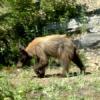^^^ A good read. I activated my orphaned DeLorme map software and entered 'devil' and then 'skookum'. The column of 'devil' related listings is huge, country wide. 'Skookum' listings are west coast, numbering over 60 in the DeLorme database. There is only one listing for Skookum Meadows ( Washington ). There are a few Skookum Lakes in Oregon. 'Skookum' is one of many names for 'Sasquatch'. Indigenous Indian tribes had their own names for the big guy: Albatwitche, B'gwas, Boqs, Chiye-tanka, Holla Yella, Nuk-Luk, Oh-mah, Opie, Seatco, Weendego are but a few examples. The map makers used historical names in many locations.
Connecticut has several locations with 'Devil' in the name.


